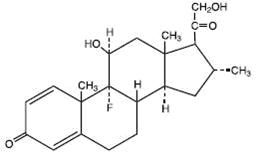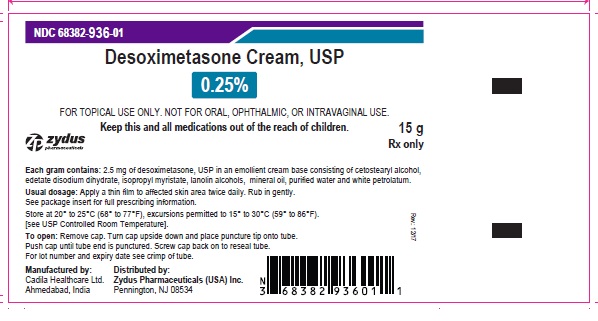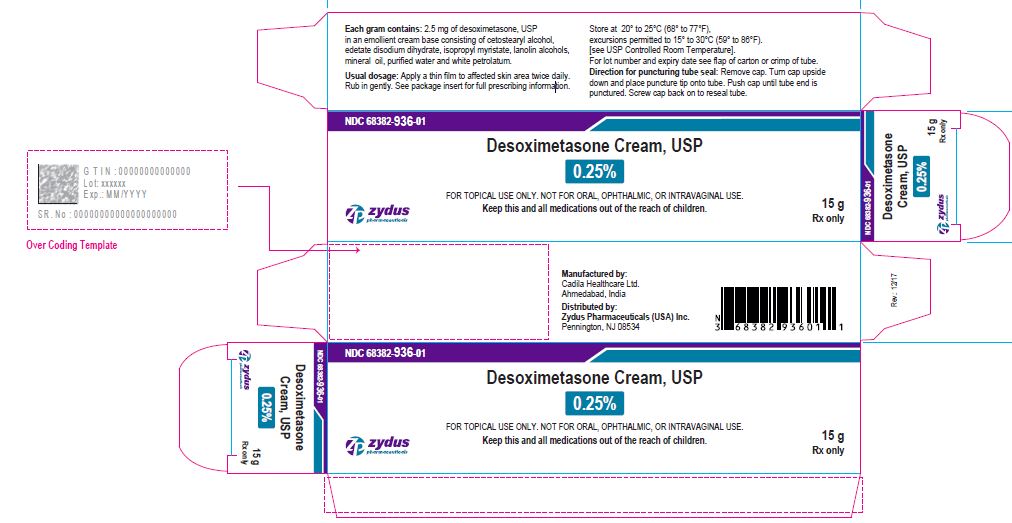desoximetasone by Zydus Pharmaceuticals (USA) Inc. / Cadila Healthcare Limited DESOXIMETASONE cream
desoximetasone by
Drug Labeling and Warnings
desoximetasone by is a Prescription medication manufactured, distributed, or labeled by Zydus Pharmaceuticals (USA) Inc., Cadila Healthcare Limited. Drug facts, warnings, and ingredients follow.
Drug Details [pdf]
- SPL UNCLASSIFIED SECTION
-
DESCRIPTION
Desoximetasone Cream USP, 0.25% contains the active synthetic corticosteroid desoximetasone, USP. The topical corticosteroids constitute a class of primarily synthetic steroids used as anti-inflammatory and antipruritic agents.
Each gram of desoximetasone cream USP, 0.25% contains 2.5 mg of desoximetasone, USP in an emollient cream consisting of cetostearyl alcohol, edetate disodium dihydrate, isopropyl myristate, lanolin alcohols, mineral oil, purified water and white petrolatum.
The chemical name of desoximetasone is Pregna-1, 4-diene-3, 20-dione, 9-fluoro-11, 21-dihydroxy-16-methyl-,(11β,16α)-. Desoximetasone has the molecular formula C22H29FO4 and a molecular weight of 376.47. The CAS Registry Number is 382-67-2. The structural formula is:

-
CLINICAL PHARMACOLOGY
Topical corticosteroids share anti-inflammatory, antipruritic and vasoconstrictive actions.
The mechanism of anti-inflammatory activity of the topical corticosteroids is unclear. Various laboratory methods, including vasoconstrictor assays, are used to compare and predict potencies and/or clinical efficacies of the topical corticosteroids. There is some evidence to suggest that a recognizable correlation exists between vasoconstrictor potency and therapeutic efficacy in man.
Pharmacokinetics
The extent of percutaneous absorption of topical corticosteroids is determined by many factors, including the vehicle, the integrity of the epidermal barrier, and the use of occlusive dressings.
Topical corticosteroids can be absorbed from normal intact skin. Inflammation and/or other disease processes in the skin increase percutaneous absorption. Occlusive dressings substantially increase the percutaneous absorption of topical corticosteroids. Thus, occlusive dressings may be a valuable therapeutic adjunct for treatment of resistant dermatoses.
Once absorbed through the skin, topical corticosteroids are handled through pharmacokinetic pathways similar to systemically administered corticosteroids. Corticosteroids are bound to plasma proteins in varying degrees. Corticosteroids are metabolized primarily in the liver and are then excreted by the kidneys. Some of the topical corticosteroids and their metabolites are also excreted into the bile.
Pharmacokinetic studies in men with desoximetasone cream, 0.25% with tagged desoximetasone showed a total of 5.2% ± 2.9% excretion in urine (4.1% ± 2.3%) and feces (1.1% ± 0.6%) and no detectable level (limit of sensitivity: 0.005 mcg/mL) in the blood when it was applied topically on the back followed by occlusion for 24 hours. Seven days after application, no further radioactivity was detected in urine or feces. The half-life of the material was 15 ± 2 hours (for urine) and 17 ± 2 hours (for feces) between the third and fifth trial day. Studies with other similarly structured steroids have shown that predominant metabolite reaction occurs through conjugation to form the glucuronide and sulfate ester.
- INDICATIONS AND USAGE
- CONTRAINDICATIONS
- WARNINGS
-
PRECAUTIONS
General
Systemic absorption of topical corticosteroids has produced reversible hypothalamic-pituitary-adrenal (HPA) axis suppression, manifestations of Cushing's syndrome, hyperglycemia, and glucosuria in some patients.
Conditions which augment systemic absorption include the application of the more potent steroids, use over large surface areas, prolonged use, and the addition of occlusive dressings. Therefore, patients receiving a large dose of a potent topical steroid applied to a large surface area or under an occlusive dressing should be evaluated periodically for evidence of HPA axis suppression by using the urinary free cortisol and ACTH stimulation tests. If HPA axis suppression is noted, an attempt should be made to withdraw the drug, to reduce the frequency of application, or to substitute a less potent steroid. Recovery of HPA axis function is generally prompt and complete upon discontinuation of the drug. Infrequently, signs and symptoms of steroid withdrawal may occur, requiring supplemental systemic corticosteroids.
Pediatric patients may absorb proportionally larger amounts of topical corticosteroids and thus be more susceptible to systemic toxicity (See PRECAUTIONS - Pediatric Use). If irritation develops, topical corticosteroids should be discontinued and appropriate therapy instituted.
In the presence of dermatological infections, the use of an appropriate antifungal or antibacterial agent should be instituted. If a favorable response does not occur promptly, the corticosteroid should be discontinued until the infection has been adequately controlled.
Information for the Patient
Patients using topical corticosteroids should receive the following information and instructions:
- This medication is to be used as directed by the physician. It is for external use only. Avoid contact with the eyes.
- Patients should be advised not to use this medication for any disorder other than for which it was prescribed.
- The treated skin area should not be bandaged or otherwise covered or wrapped as to be occlusive unless directed by the physician.
- Patients should report any signs of local adverse reactions, especially under occlusive dressing.
- Parents of pediatric patients should be advised not to use tight-fitting diapers or plastic pants on a child being treated in the diaper area, as these garments may constitute occlusive dressings
Laboratory Tests
The following tests may be helpful in evaluating the hypothalamic-pituitary-adrenal (HPA) axis suppression: Urinary free cortisol test and ACTH stimulation test
Carcinogenesis, Mutagenesis, Impairment of Fertility
Long-term animal studies have not been performed to evaluate the carcinogenic potential or the effect on fertility of desoximetasone.
Desoximetasone was nonmutagenic in the Ames test.
Pregnancy Category
Pregnancy Category C
Corticosteroids have been shown to be teratogenic in laboratory animals when administered systemically at relatively low dosage levels. Some corticosteroids have been shown to be teratogenic after dermal application in laboratory animals.
Desoximetasone has been shown to be teratogenic and embryotoxic in mice, rats, and rabbits when given by subcutaneous or dermal routes of administration in doses 3 to 30 times the human dose of desoximetasone cream, 0.25% and 15 to 150 times the human dose of desoximetasone cream, 0.05%, or desoximetasone gel, 0.05%.
There are no adequate and well-controlled studies in pregnant women on teratogenic effects from topically applied corticosteroids. Therefore, desoximetasone cream, 0.25% should be used during pregnancy only if the potential benefit justifies the potential risk to the fetus. Drugs of this class should not be used extensively on pregnant patients, in large amounts, or for prolonged periods of time.
Nursing Mothers
It is not known whether topical administration of corticosteroids could result in sufficient systemic absorption to produce detectable quantities in breastmilk. Systemically administered corticosteroids are secreted into breastmilk in quantities not likely to have a deleterious effect on the infant. Nevertheless, caution should be exercised when topical corticosteroids are administered to a nursing woman.
Pediatric Use
Pediatric patients may demonstrate greater susceptibility to topical corticosteroid-induced HPA axis suppression and Cushing's syndrome than mature patients because of a larger skin surface area to body weight ratio.
HPA axis suppression, Cushing's syndrome, and intracranial hypertension have been reported in pediatric patients receiving topical corticosteroids. Manifestations of adrenal suppression in pediatric patients include linear growth retardation, delayed weight gain, low plasma cortisol levels, and absence of response to ACTH stimulation. Manifestations of intracranial hypertension include bulging fontanelles, headaches, and bilateral papilledema.
Administration of topical corticosteroids to pediatric patients should be limited to the least amount compatible with an effective therapeutic regimen. Chronic corticosteroid therapy may interfere with the growth and development of pediatric patients.
-
ADVERSE REACTIONS
The following local adverse reactions are reported infrequently with topical corticosteroids, but may occur more frequently with the use of occlusive dressings. These reactions are listed in an approximate decreasing order of occurrence: burning, itching, irritation, dryness, folliculitis, hypertrichosis, acneiform eruptions, hypopigmentation, perioral dermatitis, allergic contact dermatitis, maceration of the skin, secondary infection, skin atrophy, striae, and miliaria.
In controlled clinical studies the incidence of adverse reactions was low (0.8%) for desoximetasone cream, 0.25% and included burning, folliculitis, and folliculo-pustular lesions. The incidence of adverse reactions was also 0.8% for desoximetasone cream, 0.05% and included pruritus, erythema, vesiculation, and burning sensation.
- OVERDOSAGE
- DOSAGE AND ADMINISTRATION
-
HOW SUPPLIED
Desoximetasone Cream USP, 0.25% is supplied in 15 gram, 60 gram and 100 gram tubes.
NDC: 68382-936-01 in tube of 15 gm
NDC: 68382-936-02 in tube of 60 gm
NDC: 68382-936-03 in tube of 100 gm
Storage
Store at 20° to 25°C (68° to 77°F), excursions permitted to 15° to 30°C (59° to 86°F). [See USP Controlled Room Temperature]
Keep this and all medications out of the reach of children.
Call your doctor for medical advice about side effects. You may report side effects to FDA at 1-800-FDA-1088.
- SPL UNCLASSIFIED SECTION
- PACKAGE LABEL.PRINCIPAL DISPLAY PANEL
-
INGREDIENTS AND APPEARANCE
DESOXIMETASONE
desoximetasone creamProduct Information Product Type HUMAN PRESCRIPTION DRUG Item Code (Source) NDC: 68382-936 Route of Administration TOPICAL Active Ingredient/Active Moiety Ingredient Name Basis of Strength Strength DESOXIMETASONE (UNII: 4E07GXB7AU) (DESOXIMETASONE - UNII:4E07GXB7AU) DESOXIMETASONE 2.5 mg in 1 g Inactive Ingredients Ingredient Name Strength CETOSTEARYL ALCOHOL (UNII: 2DMT128M1S) EDETATE DISODIUM (UNII: 7FLD91C86K) ISOPROPYL MYRISTATE (UNII: 0RE8K4LNJS) LANOLIN ALCOHOLS (UNII: 884C3FA9HE) MINERAL OIL (UNII: T5L8T28FGP) WATER (UNII: 059QF0KO0R) PETROLATUM (UNII: 4T6H12BN9U) Product Characteristics Color WHITE (WHITE TO OFF-WHITE) Score Shape Size Flavor Imprint Code Contains Packaging # Item Code Package Description Marketing Start Date Marketing End Date 1 NDC: 68382-936-01 1 in 1 CARTON 02/12/2019 1 15 g in 1 TUBE; Type 0: Not a Combination Product 2 NDC: 68382-936-02 1 in 1 CARTON 02/12/2019 2 60 g in 1 TUBE; Type 0: Not a Combination Product 3 NDC: 68382-936-03 1 in 1 CARTON 02/12/2019 3 100 g in 1 TUBE; Type 0: Not a Combination Product Marketing Information Marketing Category Application Number or Monograph Citation Marketing Start Date Marketing End Date ANDA ANDA205620 02/12/2019 Labeler - Zydus Pharmaceuticals (USA) Inc. (156861945) Registrant - Zydus Pharmaceuticals (USA) Inc. (156861945) Establishment Name Address ID/FEI Business Operations Cadila Healthcare Limited 650650802 ANALYSIS(68382-936) , MANUFACTURE(68382-936)
© 2025 FDA.report
This site is not affiliated with or endorsed by the FDA.

